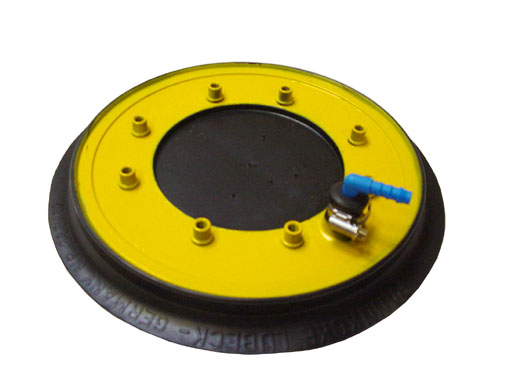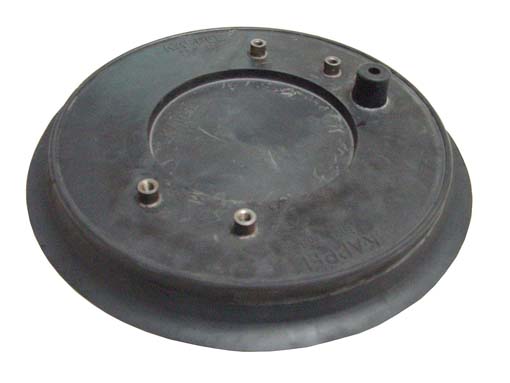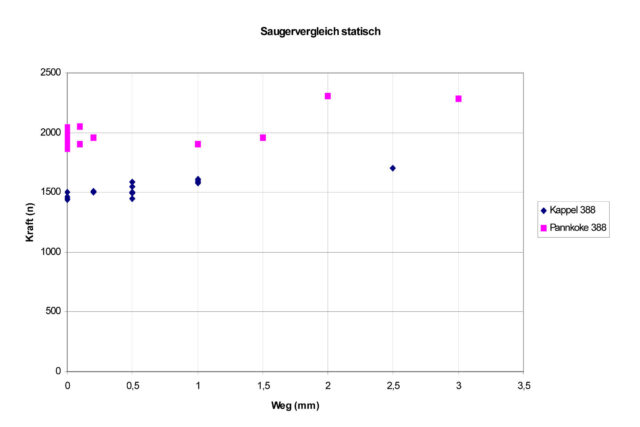

Carrying capacity of suction cups in comparison
Pannkoke 388 / Kappel 388
An investigation by the Fachhochschule Kiel
(executed in the first half year 2001)


Execution of the trial
The suction cup was placed onto a glass plate. The glass plate and the suction cup were cleaned prior to placement. A vacuum hose with -0.6 bar vacuum was connected to the suction cup. For the vacuum supply a Venturi jet with a connecting pressure tank was used.
In order to exert a force on the suction cup a load cell was fixed on the holding plate of the suction cup. Connected to the load cell was a chain. A static force was performed through the use of this chain in combination with a lever, which was weighted. The forces could be read off at the measuring bridge.
In the first part the suction cups were pulled with a constant force and the distance was measured if the suction cup experienced any movement within 5 minutes. The force was changed if the suction cup experienced no movement within 5 minutes. The suction cups were removed after each trial and then replaced on the glass plate.
In the second part the suction cups were taken to the tearing off point via an applied force on the lever. The maximum force could be read off at the measuring bridge at the Peak Hold.
The suction cup was pulled parallel to the glass plate which corresponds to the vertical lifting of glass panes.
Results
In the first column are the trial numbers. The second column shows the static load in Newton. In the third column you find the amount of movement of the suction cups after 5 minutes. Increasing or lowering of the force was tried to determine a maximum value.
Static load over 5 minutes.
| Pannkoke Type 388 | Kappel Type 388 | ||||
| Trial | Force (N) | Distance (mm) | Force (N) | Distance (mm) | |
| 1 | 1923 | 0 | 1700 | 2,5 | |
| 2 | 2307 | 2 | 1596 | 1 | |
| 3 | 2287 | 3 | 1607 | 1 | |
| 4 | 1960 | 1,5 | 1582 | 1 | |
| 5 | 1881 | 0 | 1585 | 0,5 | |
| 6 | 1955 | 0,2 | 1550 | 0,5 | |
| 7 | 1902 | 0,1 | 1460 | 0 | |
| 8 | 1902 | 1 | 1498 | 0 | |
| 9 | 1864 | 0 | 1550 | 0,5 | |
| 10 | 1875 | 0 | 1500 | 0,2 | |
| 11 | 1935 | 0 | 1491 | 0,5 | |
| 12 | 1929 | 0 | 1444 | 0,5 | |
| 13 | 1935 | 0 | 1440 | 0 | |
| 14 | 1966 | 0 | 1448 | 0 | |
| 15 | 2000 | 0 | 1499 | 0,5 | |
| 16 | 2050 | 0,1 | 1439 | 0 | |
| 17 | 2010 | 0 | 1462 | 0 | |
| 18 | 2020 | 0 | 1460 | 0 | |
| 19 | 2030 | 0 | 1466 | 0 | |
| 20 | 2040 | 0 | 1510 | 0,2 | |
| 21 | 2050 | 0,1 | |||
| 22 | 2040 | 0 |

Dynamic Load
At the dynamic load the suction cups were pulled until they tore off from the glass plate.
Result:
Pannkoke Type 388 average value = 4048 N
Kappel Type 388 average value = 4058 N
| Kappel | Pannkoke | |
| 1 | 4079 | 3994 |
| 2 | 3974 | 4210 |
| 3 | 4250 | 4102 |
| 4 | 3953 | 3910 |
| 5 | 4103 | 4105 |
| 6 | 4007 | 4040 |
| 7 | 3956 | 4205 |
| 8 | 4030 | 4005 |
| 9 | 4257 | 3956 |
| 10 | 3968 | 3957 |
| average value = | 4057,7 | 4048,4 |

